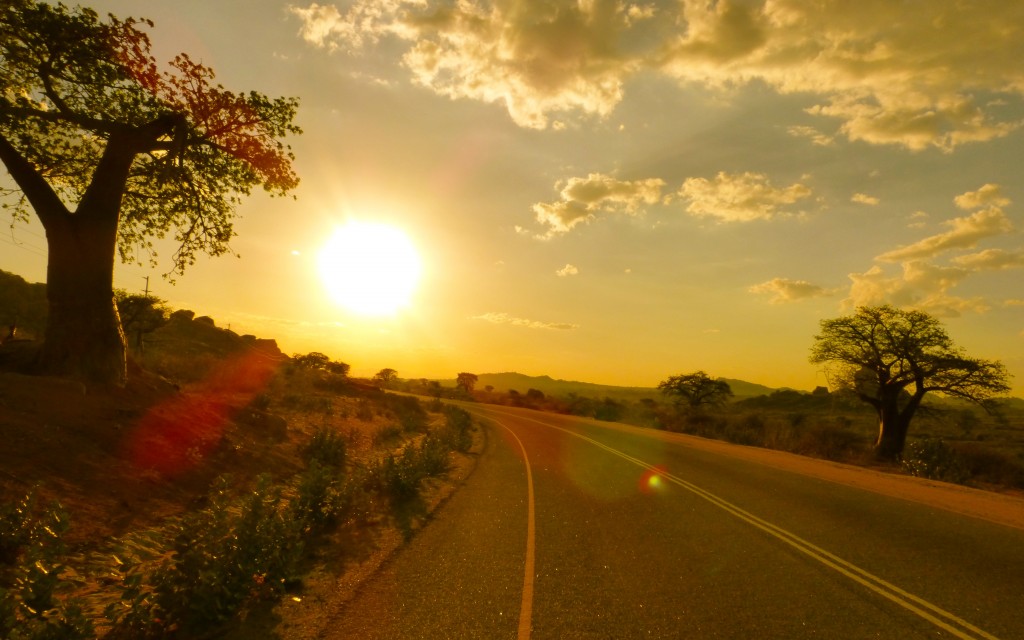African Time
by Lorrie Elchert (’94, ’04)
Photos by Pineapple XVI
We prepared for months, packaging medications and supplies, getting our immunizations and going over details and diseases. During this time we were also participating in various fundraisers. Organized by Dr. Richard Paat and sponsored by Good Hope Lutheran Church in Bucyrus, Ohio, along with the Zion Lutheran Church in Waterville, Ohio, our medical mission team readied for our journey to Tanzania, Africa. We found out two weeks before leaving, that a tractor fell on to the mountain road that we were to travel, making it impassable. It was then decided to go to a village at the base of the mountain called Kibakwe. The advance team arrived and found a church building with rooms we could stay in with a separate building we could use as our clinic. There also was a room for a pharmacy and dental area.
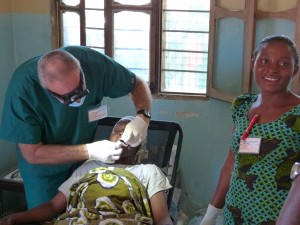 Our team consisted of Dr. Paat, Dr. Gary Gladieux and Jeffrey Breymaier, D.D.S. We also had nurse practitioners Jean Austin and Lorrie Elchert, nurses Ruth Stygles and Randy Wise and pharmacist Jamie Kosanka with us. Our engineer was the multi-mission experienced Dennis Bensch and we had the wonderful volunteer assistance of Pastor Dave Bliss, Pastor Steve Bauerle, Emily Breymaier, Emily Schneider and Becky Seibert. Our photographer who accompanied us to document the trip was Kevin Seibert.
Our team consisted of Dr. Paat, Dr. Gary Gladieux and Jeffrey Breymaier, D.D.S. We also had nurse practitioners Jean Austin and Lorrie Elchert, nurses Ruth Stygles and Randy Wise and pharmacist Jamie Kosanka with us. Our engineer was the multi-mission experienced Dennis Bensch and we had the wonderful volunteer assistance of Pastor Dave Bliss, Pastor Steve Bauerle, Emily Breymaier, Emily Schneider and Becky Seibert. Our photographer who accompanied us to document the trip was Kevin Seibert.
After long flights from Detroit to Amsterdam then Amsterdam to Kilimanjaro, we arrived at the Kilimanjaro Airport where we were greeted by Dr. Nasarri, who helped us through customs. We were awed by the deep purple night sky that glittered with every star and constellation as we journeyed to Arusha, Tanzania, where we spent the night. We awakened to the sounds of hundreds of people boarding buses to go to their jobs in nearby towns and villages. Once we got ready, we boarded a bus to Kibakwe. We stopped at a road stop for gas and were met by people of all ages, selling and bartering food, drinks, crafts and T-shirts to the tourists through the bus windows.
A four-hour journey with a few rest stops and eight police stops made the hours pass away quickly. We were told we were on African time and not to worry. Passing large baobab trees, we saw fields being hoed by hand and few ox and donkey pulling carts. On the side of the road we saw herds of goats, donkeys and livestock in the fields overseen by the Maasai herdsmen and women. Many people were walking with large amounts of bananas, wood and more than one 10-gallon bucket of water on their head and shoulders heading to their homes.
The clay dirt blew on the way up to Kibakwe and we quickly closed bus windows as vehicles passed. Our faces and jaws were sore from the vibration of the roads. It was worse than riding on the Millennium Force at Cedar Point. Bridges over the ravines were made of wood and rattled as our bus went over them. We stopped at the Mpwapwa hospital to pick up six nurses and we ended up staying overnight in the village due to it being unsafe to drive any further in the dark.
After three hours of sleep, we were back up and on the road. We arrived in Kibakwe and unloaded the bus. Right away we set up our clinic rooms and sorted supplies for the supply room and pharmacy. The prized dental chair was also assembled.
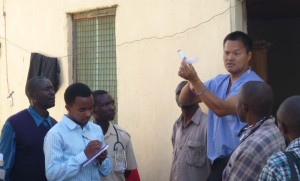 Our first task was to train 14 villagers to be health care promoters. These young men and women were eager to learn and gave up their time from their jobs and families to take on this adventure. We initially taught them to take blood pressure, listen to heart and lung sounds, suturing, putting on sterile gloves and how to deliver a baby. They then were stationed daily in different areas with different providers to promote further learning throughout our mission. On our first day of providing care a young school teacher named Joel from the village joined us to be a translator. He shared with us that he had wanted to be a doctor and he was so bright that he became our 15th health care promoter.
Our first task was to train 14 villagers to be health care promoters. These young men and women were eager to learn and gave up their time from their jobs and families to take on this adventure. We initially taught them to take blood pressure, listen to heart and lung sounds, suturing, putting on sterile gloves and how to deliver a baby. They then were stationed daily in different areas with different providers to promote further learning throughout our mission. On our first day of providing care a young school teacher named Joel from the village joined us to be a translator. He shared with us that he had wanted to be a doctor and he was so bright that he became our 15th health care promoter.
Our six nurses came from Mpwapwa and Dodoma and all worked in hospitals. Their English was excellent as was their recognition of common African diseases and treatment. They gave up time from their jobs and families to be with us feeling it was imperative to help other villages and their native people. They were excited about our equipment, like our portable pulse oximeter that they had never seen before. They were also interested in learning about our advanced practice in nursing in the U.S. Several were interested in pursuing their master’s degrees.
 As we started our first day in the clinic, we were amazed at the people. They walked hours from villages and mountain areas. They waited for hours in the hot sun, many times with little to eat or drink. One older man waited three and a half hours in the hot sun and had traveled six and a half hours that morning to see me. He was dehydrated with a pulse of 133 (initially in triage his pulse was 111). I gave him a large cup of water. He smiled and was so gracious.
As we started our first day in the clinic, we were amazed at the people. They walked hours from villages and mountain areas. They waited for hours in the hot sun, many times with little to eat or drink. One older man waited three and a half hours in the hot sun and had traveled six and a half hours that morning to see me. He was dehydrated with a pulse of 133 (initially in triage his pulse was 111). I gave him a large cup of water. He smiled and was so gracious.
They came to see us dressed in their best outfits of beautiful bright colors and patterns. The men wore suit coats and hats. Occasionally the young girls wore the same dress as their mothers. Infants were swathed in cloth and held close to their mothers. Tanzanians in this area were of the poorest in Tanzania. Very few has seen a doctor or even had a well check for their children. They were so caring, grateful and listened intently. The people used whatever resources, if any, to remedy their own problems. We saw homemade dressings to cover wounds, homemade crutches and canes to name a few. They smiled or held your hand. Sometimes the elderly kissed your hand or just hugged you. Children sat on your lap and looked at you with their big eyes and you would get a smile by the time you were finished with their examination.
The next day word had spread and our volume of patients tripled. Over 200 people were brought down from the mountain village of Lufu by bus. Many asked about our families and we shared pictures of our families. They brought their entire families for us to be examined even if they were healthy.
We provided care over the long days, working into the night using headlights for light. We saw diseases we typically don’t see, such as manifestations of TB, malaria and AIDS. Two of the many cases we saw were a nephew helping his 46-year-old uncle who had AIDS and was suffering from pneumocystis pneumonia and a tuberculosis abscess on the side of a neck of a 62-year-old woman.
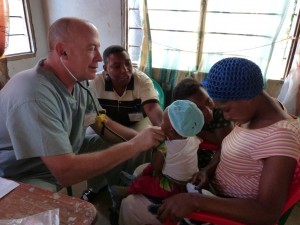 Intestinal parasitic infections were common, so everyone was treated for them in triage. We also saw other parasitic infections such as onchocerciasis or “river blindness” and several cases of lymphatic filariasis or “elephantitis.” Some of the cases we encountered were a 20-month-old boy with Marasmus (severe malnutrition), a four-year-old boy with Kwashiorkor (severe protein malnutrition), a 60-year-old lady with a huge goiter, a child with severe hydrocephalus, a 17-year-old with osteomyelitis of a foot and a seven-year-old girl with hypoplasia of the lower jaw. Asthma and allergies were common from dust and the smoke of cooking on an open fire. Dental care involved many extractions, several infections and one that eroded into the sinus cavity. Vision changes were frequently seen from dust and UV due to no sunglasses or hat for protection. We ran out of glasses and sunglasses in a day and half. Muscle and joint pains from lifting or carrying for hours daily took its toll on the human body. People often walked two miles from a well to their home with two 10-gallon buckets of water on their head. Cracking dry feet with tinea (fungal foot infections) from the toil of walking with no shoes were seen daily. Many of the medications that we used for these common disorders became in short supply. We did not deliver any babies and but we did see one laboring young mother. A minor surgery removing a fatty tumor from the side of a young man’s neck was performed by nurse practitioner Jean Austin.
Intestinal parasitic infections were common, so everyone was treated for them in triage. We also saw other parasitic infections such as onchocerciasis or “river blindness” and several cases of lymphatic filariasis or “elephantitis.” Some of the cases we encountered were a 20-month-old boy with Marasmus (severe malnutrition), a four-year-old boy with Kwashiorkor (severe protein malnutrition), a 60-year-old lady with a huge goiter, a child with severe hydrocephalus, a 17-year-old with osteomyelitis of a foot and a seven-year-old girl with hypoplasia of the lower jaw. Asthma and allergies were common from dust and the smoke of cooking on an open fire. Dental care involved many extractions, several infections and one that eroded into the sinus cavity. Vision changes were frequently seen from dust and UV due to no sunglasses or hat for protection. We ran out of glasses and sunglasses in a day and half. Muscle and joint pains from lifting or carrying for hours daily took its toll on the human body. People often walked two miles from a well to their home with two 10-gallon buckets of water on their head. Cracking dry feet with tinea (fungal foot infections) from the toil of walking with no shoes were seen daily. Many of the medications that we used for these common disorders became in short supply. We did not deliver any babies and but we did see one laboring young mother. A minor surgery removing a fatty tumor from the side of a young man’s neck was performed by nurse practitioner Jean Austin.
We tried to include changes in activity, diet, exercises and provide more prevention ideas; not just pass out medications. One gentleman returned the next day to inform us the medicine he received was too strong. He had received a multivitamin. Dr. Nasarri arranged for follow up appointments in the clinic in Mpwapwa for patients that needed it or who were treated for tuberculosis. Tanzanian government treats and regulates all tuberculosis cases. Other patients were set up to be followed by the village’s health promoters that we had trained. Each village was provided a cell phone for their health care promoter in order to contact a physician locally. The phones were provided by our Lutheran church sponsors.
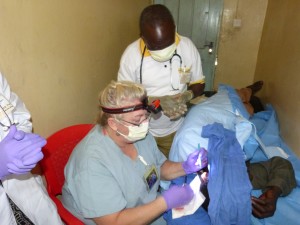 On our last night we awarded certificates to all of the health care promoters and nurses. They rewarded us with the sound of their voices singing beautifully which we will always remember. Sunday, our last day, we went to church in Kibakwe and found the service breathtaking. Tanzanians’ life revolves around their family, especially their children, their religion and music.
On our last night we awarded certificates to all of the health care promoters and nurses. They rewarded us with the sound of their voices singing beautifully which we will always remember. Sunday, our last day, we went to church in Kibakwe and found the service breathtaking. Tanzanians’ life revolves around their family, especially their children, their religion and music.
Many people questioned why I was going to Tanzania and my response was “why not?” The conditions don’t matter if you are providing care. You simply overlook the conditions and provide care to anyone in need. Perhaps it was also to strengthen our inner self. I felt a strong bond with the Tanzanian people. They were so rich in family and spirituality and were truly wealthy in my eyes. On the last day I saw a 96-year-old lady. She removed her bright cloth shawl so I could examine her and I found a T-shirt that said “Girls’ Locker Room, Aeropostale.” I smiled and told her that my teenage daughter would wear that too. She kissed my hand and I kissed hers. She mumbled softly in Swahili and I asked for a translation. My translation was “you are a blessing, you are a blessing, I am blessed to be with you.” When I left, I felt that I was the one truly blessed. Our entire mission team shared this feeling in Tanzania.
Even after a 25-hour flight home, we all shared thoughts of returning to Tanzania. We are already planning our next trip to Kibakwe in 2014. Dr. Gladieux is arranging to bring the seven-year-old girl with hypoplasia of her jaw to the U.S. for reconstructive surgery. Jean and Lorrie are assisting the local nurses with pursuing their master’s degrees and are setting up collections for sunglasses, used glasses and school supplies. We are all in communication with the local nurses and some of the health care promoters by email and Facebook. In the fast-paced, hectic-life back at home in the U.S., we look back and think how nice it would be to be back on African time.
To watch a video put together by the photographer including interviews of many of the people who attended, click here.
To watch a video of surgery being performed while in Kibakwe, Tanzania, click here.


